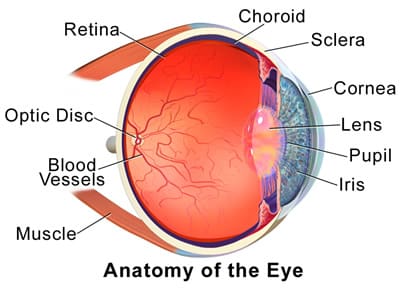Menu
Menu

In addition to your cornea, the lens in your eye is responsible for focusing the light onto the retina in the back of the eye, just as a camera lens would focus light onto the film in a camera. Being diagnosed with cataracts means that your naturally clear lens (behind the iris or colored part of your eye) has become opaque or hazy.
Cataract surgery involves removing the lens and replacing it with a new clear acrylic lens. This lens implant remains inside the eye permanently and does not require care.
Until about the age of 40, your natural lens is able to accommodate or change its power to allow near vision, even when the distance vision is corrected. After this time, accommodative power begins to weaken. This loss of accommodation is called presbyopia and people often need bifocals or reading glasses to compensate.
When the lens/cataract is removed during surgery, any residual accommodative power is lost, but the patient has the benefit of being able to choose the power or type of new lens implant to customize the result to their specific needs.
In addition, some patients have what is called an astigmatism. In a patient without an astigmatism, their cornea is shaped like a basketball. Because of this, the light going through the lens hits the back of the eye the same way in all areas. When someone has an astigmatism, their cornea is shaped like a football instead of a basketball, which changes the way the light is hitting some areas of the retina. Patients that have an astigmatism will still require the use of glasses for near and distance to correct their astigmatism unless they have a specialty lens.
None of the implant options guarantee that you will be free of glasses, but patients often have a reduced dependence on glasses or no longer need them at all.

The current lens option covered by insurance is a monofocal lens. The monofocal lens can correct your vision for either near vision or distance vision, but not both.
There are several specialty lenses now approved through the FDA that are not covered by insurance. These lenses give you an even higher probability of being free of glasses after surgery. Not all options are right for every patient. Your doctor will be able to recommend what will be best for you and your lifestyle.
Toric Monofocal Lens- This lens is used for patients with a high astigmatism. The goal is to best-correct your distance vision. With this lens you will still need to wear glasses for reading and may require glasses for mid-range vision (computer work).
Multifocal or Extended Depth of Focus Lens- These lenses are used to best-correct distance, mid-range and near vision without the use of glasses. You may still require reading glasses for fine print.
Toric Multifocal or Extended Depth of Focus Lens- These lenses are used to best-correct the distance, mid-range, and reading vision even with a high astigmatism. You may still require reading glasses for fine print.
The Multifocal lens enables you to see distance, mid-range, and near in separate areas of vision. This means that while looking at your phone, it will be clear, but if you slowly pull it away from you, it will become slightly blurry until it reaches the mid-range section of your vision when it will become clear again. The benefit of this lens option is the ability to correct for fine print reading.
An Extended Depth of Focus Lens will correct distance, mid-range and some near vision clearly without the separate areas of vision. However, it may not allow for fine print reading.
Talk to your doctor to see if “mono-vision multi-vision” is right for you. In this scenario, there would be an EDF lens in your dominant eye, thereby correcting your distance and mid-range vision clearly without areas of blurriness, and a multifocal lens in your non-dominate eye enabling fine print reading in addition to distance and mid-range.
Cataract surgery is an outpatient procedure that generally takes about 10-15 minutes, however the stay at the surgical facility will usually last between 2 and 4 hours for workup and discharge. Most surgical facilities require the patient be accompanied by a friend or relative at the time of discharge. Surgery is usually done under local/topical anesthesia. Patients are understandably nervous about being awake for eye surgery, but are routinely very surprised at the ease and comfort of the procedure. Patients typically return to their normal activities within a few days.
The usual routine involves starting antibiotic and anti-inflammatory drops 1-2 days before surgery and then employing a tapering course of drops over the next few weeks. These drops decrease the chance of infection, increase comfort, and allow a faster and more complete restoration of vision. A few weeks after the surgery, new glasses may be prescribed, if needed.
About 15-20% of patients will develop an “after-cataract” in the weeks, months or years after the surgery. This means the lens capsule (the transparent membrane around the original lens/cataract) that holds the lens implant itself became hazy. Fortunately this is easily treated in the office with a painless laser and it takes just a couple of minutes.
Dr. Myers and Dr. Lorenz are now offering combined Cataract surgery with iStent placement for glaucoma.